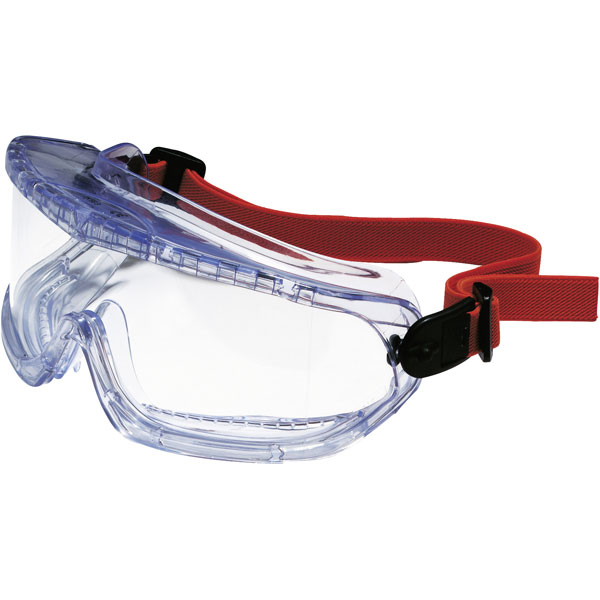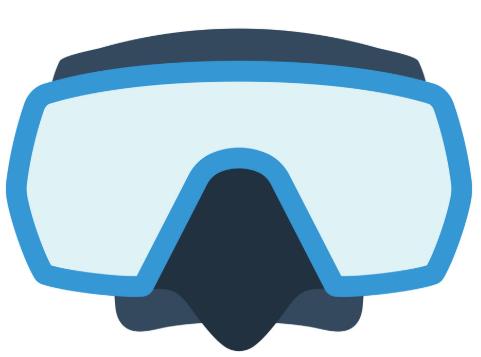GOGGLES PANORAMIC, regular nose, indirect ventilation
Valid Article
PANORAMIC GOGGLES
Definition
Goggles, or safety glasses, are protective eyewear that usually enclose or protect the area surrounding the eye in order to prevent particulates, water or chemicals from striking the eyes. In haemorrhagic fever contexts it is recommended to use safety wrap around goggles: they protect the eyes from dust and splashing.
Specifications
Technical specifications
Markings written on the goggles according to the EN 166 specifications:
- Mechanical class = F = Minimum mechanical resistance (resistance to shocks of low-energy particles): withstands a bead of 6 mm and 0.85 g at 45m/s impact
- Optic class = 2 = applicable for intermittent use, for activities with medium visual requirements
Ventilated versus non ventilated
- Not ventilated = waterproof = sealed (SSPEGOGPRN1 )
- Indirect ventilated (SSPEGOGPRV1 and SSPEGOGPWV1): a venting system that does not allow for direct contact of particles to the interior of the goggles. E.g.: angled vents, prefereably at the bottom, which face away from the front lens that the wearer looks through. This reduces the fogging.
Lens
- Material: mechanically strong but less flexible polycarbonate (PC) or a better chemical resistant acetate type (PA) are equivalent options
- Clear lens for protection against UV light
- Panoramic view 180°
- The optical zone for every eye must be at least 32 mm horizontally and 25 mm vertically
- Replaceable
- Treated against fogging and against scratching
- Must be easy to disinfect and resistant to chlorine à.5% solution
Frame
- Good seal with the skin of the face
- Shape of nose bridge: Regular (SPPEGOGPRN1 and SPPEGOGPRV1 ) or wide (SPPEGOGPWV1 )
- Covers the eyes and big part of the cheek (important in VHF context: between hood and respirator)
- Parts that touch the skin may not be allergenic or irritating
- Easy to combine with corrective glasses
- Made in thermoplastic elastomer
- Flexible frame that easily fits all face contours and accommodates prescription glasses
- Broad and fully adjustable headband that does not become loose during clinical activity.
- Must be easy to disinfect and resistant to chlorine 0.5% solution
Instructions for use
The ocular should be cleaned regularly. It can be cleaned with water and soap, or cleaning fluid for glasses.
In case the goggles should be cleaned with a chlorine solution, it is necessary to clean it afterwards with water and soap, and rince it thoroughly with clear water. No traces of chlorine should be left over because these traces will quickly result in fogging.
Scratched ocular should be replaced (see related articles).
If the elastic strap is damaged, the entire goggle needs to be replaced.
Precautions for Use
In order to maintain your goggles
- avoid scratching or rubbing by keeping them safe in a protective pouch
- clean your lenses after each use
- remove any chlorine or other harmful chemicals: gently wash them with lukewarm water
- leave the goggles to dry and, in the case of PC lenses (anti-fog coating), try to avoid rubbing the lenses or touching them, as this may start to remove the coating
MSF requirements
The goggles are part of the full personal protective equipment worn in VHF contexts. Indispensable item for the protection of staff and patients' attendants against blood-borne pathogens in haemorrhagic fever contexts.
Must be disinfected with chlorine solution and easy to remove.





![[KMEDMLAB113] (laboratory mod) TUBERCULOSIS EQUIPMENT microscopy 1000tests](/web/image/product.template/573144/image_256/%5BKMEDMLAB113%5D%20%28laboratory%20mod%29%20TUBERCULOSIS%20EQUIPMENT%20microscopy%201000tests?unique=e173814)
![[KMEDMEBO13A] (module VHF) MODULE ENVIRONMENTAL HEALTH](/web/image/product.template/571761/image_256/%5BKMEDMEBO13A%5D%20%28module%20VHF%29%20MODULE%20ENVIRONMENTAL%20HEALTH?unique=8f85d22)
![[KMEDMEBO03-] (module VHF isolation) PROTECTIVE EQUIPMENT](/web/image/product.template/571782/image_256/%5BKMEDMEBO03-%5D%20%28module%20VHF%20isolation%29%20PROTECTIVE%20EQUIPMENT?unique=bf82f3a)
![[KMEDMEBO11-] (module VHF) TRAINING MODULE](/web/image/product.template/571738/image_256/%5BKMEDMEBO11-%5D%20%28module%20VHF%29%20TRAINING%20MODULE?unique=fb9a656)
![[KMEDMEBO12A] (module VHF) MODULE SUPPORT 1 HOSPITAL + 10 PHC](/web/image/product.template/571737/image_256/%5BKMEDMEBO12A%5D%20%28module%20VHF%29%20MODULE%20SUPPORT%201%20HOSPITAL%20%2B%2010%20PHC?unique=fb9a656)
![[KMEDMEBO17A] (module VHF) SAMPLING AND SMALL ISOLATION](/web/image/product.template/571758/image_256/%5BKMEDMEBO17A%5D%20%28module%20VHF%29%20SAMPLING%20AND%20SMALL%20ISOLATION?unique=fb9a656)
![[KMEDMHMI22-] MODULE, VHF INVESTIGATION 2 persons/10 samples 2021](/web/image/product.template/574349/image_256/%5BKMEDMHMI22-%5D%20MODULE%2C%20VHF%20INVESTIGATION%202%20persons-10%20samples%202021?unique=d19c638)
![[SPPEGOGPS5-] (goggles) ANTIMIST SPRAY, 500 ml](/web/image/product.template/572954/image_256/%5BSPPEGOGPS5-%5D%20%28goggles%29%20ANTIMIST%20SPRAY%2C%20500%20ml?unique=3bd5915)
![[SPPEGOGPU101] (goggles indirect ventilation, Ultravision) PANORAMIC LENS](/web/image/product.template/572953/image_256/%5BSPPEGOGPU101%5D%20%28goggles%20indirect%20ventilation%2C%20Ultravision%29%20PANORAMIC%20LENS?unique=6c41b90)